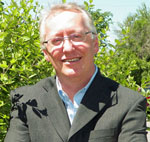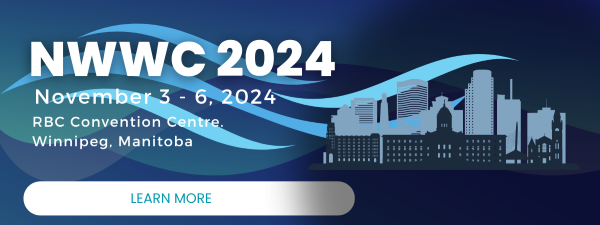 |
||||||||||||||
| Subscribe | Past Issues | www.cwwa.ca | Water Source Magazine | ||||||||||||||
|
CWWA News
As the federal government is developing new, long term funding programs for Canadian infrastructure, they have turned to the CWWA to provide input from the perspective of Canada’s water, wastewater and stormwater utilities. CWWA representatives have met directly with senior policy staff within Infrastructure Canada, the Canada Infrastructure Bank, Public Safety Canada, Environment and Climate Change Canada and appeared before the Parliamentary Standing Committee on the Environment and Sustainability. We have also assisted in arranging for senior Infrastructure Canada staff to meet directly with Utility Managers across Canada, to hear firsthand the challenges we are facing and the critical need for federal funding. Federal Initiatives
The federal government is continuing to work towards updating the Environmental Assessment Act and process. The Act puts in place a process for assessing the environmental, health, social and economic effects of designated projects. The Act has been recently amended by the Budget Implementation Act This document outlines requirements for cruise ships operating in Canadian waters regarding the discharge of sewage and release of greywater. It prohibits such discharges within three nautical miles of shore, ice-shelves, or fast ice, and imposes specific treatment and effluent standards for discharges between three and twelve nautical miles. Exceptions and reporting requirements are also detailed. This abstract was generated by artificial intelligence on 25 June 2024. While not specifically relevant to municipal water and wastewater utilities it is interesting to see how different industries manage their wastewater discharges. Canada has launched its 2030 Nature Strategy and the accompanying Nature Accountability Bill to address biodiversity loss and fulfill commitments under the Kunming-Montréal Global Biodiversity Framework. The strategy outlines actions to protect nature, backed by over $12 billion in investments since 2015, aiming to conserve 30% of land and water by 2030. The bill mandates the creation and reporting of national nature strategies to ensure transparency and accountability. Efforts include consulting stakeholders, signing nature agreements with provinces, and investing in Indigenous-led conservation initiatives. The strategy and bill represent a coordinated approach to reversing biodiversity loss and promoting a nature-positive economy. NRCAN has introduced Regulations Amending the Energy Efficiency Regulations, 2016. These amendments would advance energy efficiency in Canada and harmonize energy efficiency standards with those in the United States. Of interest to water utilities the amendments would
The Regulations would also set new standards for heating and cooling systems for residential and industrial purposes, air compressors and lamps. With an expected 400 delegates the National Water and Wastewater Conference has become THE Utility Leadership event in Canada. We are excited to launch the preliminary conference program. We're still working on refining sessions and confirming speakers, but this gives you a great sneak peak into the great sessions and speakers we have lined up. We'll be adding some curated sessions on utility management that will add an entire extra stream for part of the Conference.
Provincial News
This document provides tips for all Albertans, including businesses and their employees, on conserving water both indoors and outdoors. It highlights general requirements for businesses, such as checking for leaks, installing water-efficient fixtures, reminding staff to use water wisely, and utilizing water conservation technologies in various operational areas. Alberta is investing over $236 million in grants for 125 local transportation and water infrastructure projects in small and rural communities, aimed at creating jobs and supporting growth. The Strategic Transportation Infrastructure Program (STIP) will distribute $65.8 million for 86 road, bridge, and airport projects, including significant grants for Red Deer County, East Prairie Metis Settlement, Grande Prairie County, and Valleyview. The Alberta Municipal Water/Wastewater Partnership (AMWWP) and Water for Life program will allocate $170.3 million for 39 water and wastewater projects, with notable grants for Athabasca County, the Town of High River, the Town of Nanton, and the West Inter-Lake District. These investments, part of Budget 2024, are crucial for improving travel safety, attracting investment, and enhancing the quality of life in Alberta Join Waters Corporation for an insightful webinar on PFAS Analysis by EPA 1633 using LC-MS/MS. Learn essential techniques, best practices, and future advancements in PFAS testing to elevate your lab's capabilities. Perfect for environmental professionals committed to excellence in water quality testing. Register now for expert guidance and live Q&A! Snippings & Clippings
ES&E Magazine4 In almost all regions of North America, municipal wastewater treatment plants are surrounded by industry affecting their daily influent and resulting effluent. “Industry” has become synonymous with “unpredictability”, from the upstream distillery randomly dumping wastewater filled with high organic matter, to local manufacturing plants discharging toxic effluent. Science In July 2022, Evie Fachon was aboard the research vessel Norseman II searching for tiny but dangerous creatures lurking off the Alaskan coast. As the vessel approached the Bering Strait, the Woods Hole Oceanographic Institution (WHOI) Ph.D. student watched as counts of the single-celled organism Alexandrium catenella ticked up in images of water samples. She and colleagues were sailing through dense concentrations of a dinoflagellate at the base of the food web that produces toxins that can lead to paralytic shellfish poisoning. By the end of the cruise, the team detected the largest toxic bloom of A. catenella ever seen in polar waters, stretching at least 600 kilometers and triggering risk advisories about potentially unsafe marine harvests. The Spokesman-Review The United States and Canada announced Thursday that they have reached an agreement in principle to modernize the Columbia River Treaty, a 60-year-old pact that governs how the two nations use the Columbia Basin’s water resources. President Joe Biden and Prime Minister Justin Trudeau, both in the U.S. capital for a summit of the NATO alliance, hailed the agreement, which would last for 20 years. It will be revised based on feedback in the coming weeks as the two countries draft an amendment to the treaty, which was ratified in 1961 and first implemented in 1964. Water Canada A McGill-led research team has developed the first real-time, on-site technology capable of detecting and deciphering nanoplastics from all other particles in water, a capacity akin to being able to find a needle in a haystack within milliseconds. Water Canada Funding from the province will help replace a stormwater system and surrounding infrastructure in downtown Dartmouth. “This is a landmark project for downtown Dartmouth that we’re very excited to be supporting,” said Timothy Halman, Minister of Environment and Climate Change and MLA for Dartmouth East, on behalf of John Lohr, Minister of Municipal Affairs and Housing. “It will make a huge difference, both in improving the aging stormwater system and in improving an area of downtown Dartmouth where people walk, bike and drive every day.” ES&E Magazine The City of Charlottetown in Prince Edward Island won the Best of the Best Water Taste Test at the American Water Works Association’s (AWWA) Annual Conference and Exposition (ACE24) in Anaheim, California. ES&E Magazine British Columbia’s attorney general says she wants to take the lead on holding PFAS manufacturers accountable for contamination that has affected drinking water systems across Canada. ES&E Magazine More than 200,000 Halifax-area residents were under a boil water advisory on July 1 for about 40 hours, following an electrical issue at the JD Kline Water Treatment Facility that allowed a small amount of unchlorinated water to enter the system. Water Canada The Water Security Agency (WSA) is taking proactive measures to ensure water structures continue to serve the diverse needs of west central Saskatchewan. WSA is working on seven major capital projects worth $20 million near Lake Diefenbaker as part of its 10-year Infrastructure Rehabilitation Plan and ongoing maintenance and safety improvement projects. Bloomberg Law The House passed legislation on Tuesday aimed at protecting water infrastructure by requiring “do not flush” be printed on the containers of non-flushable wipes. Quinte News Belleville City Council is supporting a resolution by the Township of Pelee to make the provincial and federal governments aware that rural and small urban water and wastewater systems are financially unsustainable. |
||||||||||||||








